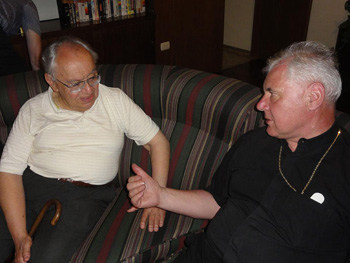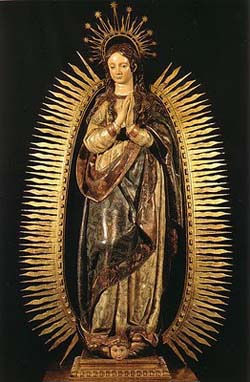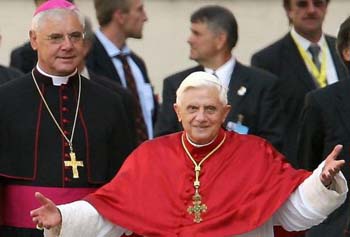 |
Consequences of Vatican II
Bishop Muller Denies
The Perpetual Virginity of Our Lady
Margaret C. Galitzin
The Pope’s recent appointment of fellow German theologian, Bishop Gerhard Ludwig Müller, to lead the Vatican’s doctrinal office responsible for enforcing orthodoxy, is troubling. As prefect of the Congregation for the Doctrine of the Faith (CDF), Bishop Muller’s profession of the Catholic Faith should be above suspicion.
It is not. First it is well known that he is sympathetic to Liberation Theology, known for its Marxist base. He is a close friend and defender of Fr. Gustavo Gutiérrez, considered one of the movement’s fathers in Latin America.

Liberation theologian Gustavo Gutiérrez and Bishop Muller - a warm relationship |
Commenting on Gutierrez, Muller stated, "The theology of Gustavo Gutiérrez, independently of how you look at it, is orthodox because it is orthopractic and it teaches us the correct way of acting in a Christian fashion since it comes from true faith." (1).
Muller’s appointment is already being considered a sign of a positive re-evaluation of Liberation Theology on the part of the Vatican.
I believe this is also significant evidence that Pope Ratzinger’s purported opposition to Liberation Theology is only a sham. In fact in a recent interview with Mittelbayerische Zeitung, a “relaxed and at ease” Müller confirmed his commitment to Liberation Theology and asserted that he and the Pope were in “total agreement” on the topic. (2)
Second, there appear to be serious doctrinal deviations in Muller’s words and works. One of the most blatant is his denial of the perpetual virginity of the Blessed Virgin Mary.
An offense to Our Lady
In his 900-page work Katholische Dogmatik. Für Studium und Praxis der Theologie (Catholic Dogmatic - For the Study and Practice of Theology), Müller in effect denies the dogma of the perpetual virginity of the Blessed Virgin Mary.

Based on a Council loophole, Muller questions Mary's perpetual virginity |
He claims that this doctrine is "not so much concerned with specific physiological proprieties in the natural process of birth (such as the birth canal not having been opened, the hymen not being broken, or the absence of birth pangs), but with the healing and saving influence of grace of the Savior on human nature."(3)
As Atila Guimaraes points out in Animus Injuriandi I (Desire to Offend), for a Catholic to question the virginal birth of Our Lord Jesus Christ, the virginitas in partu, “constitutes a supreme offense to the Faith. It is even graver because the Church has repeatedly pronounced herself on this matter.” (4)
At the Lateran Council of 649, for example, the Church speaks quite clearly on this matter: “If anyone does not properly and truly confess in accord with the holy Fathers, that the Holy Mother of God and ever Virgin and Immaculate Mary in the earliest of the ages conceived of the Holy Spirit without seed, namely, God the Word Himself specifically and truly, who was born of God the Father before all ages, and that she incorruptibly bore [Him], her virginity remaining indestructible even after His birth, let him be condemned.” (5).
Reaffirming this teaching, Pope Pius IV wrote in the Constitution Cum quorundam (1555): “The opinion is condemned that Jesus Christ was not conceived according to the flesh by the Holy Spirit in the womb of the Blessed Virgin Mary, ever Virgin ... or that the same Most Blessed Virgin Mary is not the true Mother of God and did not retain her virginity intact before the birth, in the birth, and after the birth in perpetuity.” (6)
Vatican II questions the virgin birth
This has been the constant teaching of the Church – until Vatican II. As Guimarães points out, based on a “loophole” in Lumen gentium, a new interpretation of the virginity of Our Lady has been made by conciliar theologians. According to that document’s final redactor, Msgr. Gérard Philips, the wording of the line on this topic was carefully crafted to open the question about the virgin birth: “The Son did not diminish her virginal integrity, but rather consecrated it.” (n. 57)
He justifies this choice of words by stating that many legitimate questions had been raised of late about virginitas in partu. “One thing is certain,” Philips continues, “the virginity in question is not taught as a personal privilege of Mary.” (7)
Müller also finds refuge for his position in the teachings of conciliar theologians like Karl Rahner, the mentor of Joseph Ratzinger. Rahner openly contests Our Lady’s virginity during childbirth and demands eyewitness accounts as necessary for Tradition to be credible. Along with Liberation theologian Leonardo Boff, he claims the virginity of Mary is a simple metaphor conditioned by the time’s over-valuation of virginity, and has nothing to do with the concept of physical virginity. (8)
Perhaps this is why progressivist theologians are scorning traditionalists who affirm that Muller’s commentaries on Our Lady’s virgin birth are unorthodox. Not so, the progressivists respond, based on Lumen gentium and Rahner. They say that traditionalists like me are simply reading it out of context.

Benedict XVI and Muller: in perfect accord on doctrine |
And, in fact, read in the context of the documents of Vatican II, Muller’s thinking is perfectly in line with the Conciliar Church – and the present Pope. Let us not forget that it was Fr. Joseph Ratzinger together with Fr. Karl Rahner who sabotaged Mariology at Vatican II, which is demonstrated in another place on this website.
Muller confirmed his solidarity with Benedict XVI in his first interview after his appointment as CDF prefect, to KNA - the German Bishops’ news agency. He expressed his gratitude in the Pope’s confidence in him. He also insisted that Benedict XVI was fully familiar with his theology and thinking: “The Holy Father knows me, and my theological work, not only as an author, but also as an expert of the Bishops’ Synod in Rome and in the committees of Ecumenism and Faith of the German Bishops’ Conference.” (9)
I don’t think there can be any doubt: Benedict XVI and Bishop Müller are on the same page in their adherence to Vatican II and the new conciliar theology that emerged from it. Certainly there is no hermeneutics of continuity here – on the doctrine of Our Lady’s perpetual virginity – but rather, as Guimarães notes, a clear rupture with the past teaching of the Church.
To have an unorthodox prefect of the Congregation for the Doctrine of the Faith does not predict good times ahead for the Church… Instead, what is predictable are more sophisms, more confusion, more diabolical disorientation. No human can know how long this will last.
1. "A liberation theologian in the Holy Office?" Vatican Insider, October 15, 2011;
2. In German, here
In English, here
3. Freiburg. 5th Edition, 2003;
4. A.S. Guimaraes, Animus Injuriandi I, Los Angeles: TIA, …, p. 109;
5. Denzinger/Ferarri, No. 256, Canon 3;
6. http://campus.udayton.edu/mary/resources/virofmary.htm;
7. Apud A.S. Guimaraes, Animus Injuriandi I, footnote 41, pp. 110-111;
8. Apud ibid., pp. 113-117;
9. http://rorate-caeli.blogspot.com/2012/07/muller-speaks-church-of-large-rooms.htm

Posted July 11, 2012

Related Topics of Interest
 The Hermeneutics of Rupture The Hermeneutics of Rupture
 Bishop Gerhard Muller Welcomes Punk Girls Bishop Gerhard Muller Welcomes Punk Girls
 Rahner & Ratzinger Sabotaged Mariology at Vatican II Rahner & Ratzinger Sabotaged Mariology at Vatican II
 The Five Sins Against Our Lady The Five Sins Against Our Lady
 The Vatican - A New Mentor for Liberation Theology? The Vatican - A New Mentor for Liberation Theology?

Related Works of Interest
|
|
Vatican II | Hot Topics | Home | Books | CDs | Search | Contact Us | Donate

© 2002-
Tradition in Action, Inc. All Rights Reserved
|
 |
|